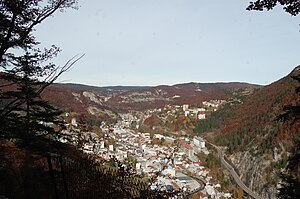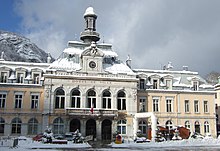Morez
| Morez | ||
|---|---|---|

|
|
|
| local community | Hauts de Bienne | |
| region | Bourgogne-Franche-Comté | |
| Department | law | |
| Arrondissement | Saint-Claude | |
| Coordinates | 46 ° 31 ' N , 6 ° 1' E | |
| Post Code | 39400 | |
| Former INSEE code | 39368 | |
| Incorporation | January 1, 2016 | |
| status | Commune déléguée | |
| Website | www.ville-morez.fr | |
 View over Morez from south to north |
||
Morez is a town and commune Déléguée in the French commune of Hauts de Bienne with 4,848 inhabitants (as of January 1 2017) in the Jura department in the region of Bourgogne Franche-Comté .
geography
Morez is located at 702 m , about 20 km northeast of the city of Saint-Claude and 40 km north of Geneva (as the crow flies). The small town extends in the high Jura , in a transverse valley cut deep into the Jura chains, on both sides of the upper reaches of the Bienne , between the heights of Bois de Bevet in the west and Risoux in the east.
The area of the 9.67 km² Commune déléguée covers a section of the French Jura. The central part is taken by the Klustal von Morez, which follows one of the great transform faults in the Jura. This transverse valley is traversed from south to north by the Bienne, which takes the Evalude from the right below the center of the village and then draws a sharp curve and flows through a deeply cut valley to the southwest. In the Morez area, the flat valley floor of the Bienne has a maximum width of 250 m.
The Morez valley is flanked on both sides by steeply rising slopes with protruding rocky outcrops. On its west side, the valley is dominated by the Roche au Dade , the Roche Fendue and the Rocher du Béchet , from which there is a beautiful view of Morez. The area of the Commune déléguée extends to the adjacent, wooded high plateau des Bois de Bevet (up to 1050 m ). The northern boundary runs along the Bienne and the slope below Morbier, while the southern boundary is in the area of the Talenge at Pont des Douanes below the Rocher du Béchet.
To the east, the area of the Commune déléguée extends over the Roche Brûlée ( another lookout point at 1043 m ) to the Anticline des Risoux. This plateau with aboveground drainage-free depressions and railing ribs in between is densely forested. In the extreme northeast of the municipal ban, the highest point of Morez is reached on the Crêt à la Dame with 1311 m . The area of the Commune déléguée is part of the Haut-Jura Regional Nature Park (French: Parc naturel régional du Haut-Jura ).
In addition to the actual village, the Commune déléguée Morez also includes various settlements and individual farms, including:
- Bas de Morez ( 691 m ) at the confluence of the Evalude in the Bienne
- Villedieu ( 745 m ) on the eastern slope of the Bienne
- Sur Les Puits ( 815 m ) on a ledge on the eastern slope of the valley
Neighboring towns of Morez are Morbier and Bellefontaine in the north, Les Rousses in the east, Longchaumois in the south and La Mouille in the west.
history
The settlement of the valley floor of today's Morez began very late. The beginnings go back to the early 16th century, when one began to use the water power of the Bienne in the cross valley, then called Combe Noire , to drive mills. A pioneer in the use of water power was Étienne Morel, who introduced the first industries in 1563, namely sawmills and forging. At the same time, a workers' settlement was built, which was initially called Combe-à-Morel . Later the name changed via Morel-sous-Morbier and Morey to today's Morez. During the 16th and 17th centuries, Morez developed into an industrial settlement. A new branch of industry established itself from 1660 with the introduction of the watch industry .
In territorial terms, Morez belonged to La Mouille , which in turn was subject to the rule of the Abbey of Saint-Claude. In 1776, Morez was separated from La Mouille and raised to an independent municipality.
Located on an important transport route from the Geneva region through the Jura to Dole and Dijon , Morez also profited from trade. In the course of the 18th century, the industry diversified further by adding tannery, wire drawing and linen weaving to the traditional branches. Around 1800 the manufacture of glasses and glasses frames was introduced, which in the course of the 19th century became Morez's most important branch of industry. The first half of the 19th century was characterized by industrialization and the mechanization of production. This was accompanied by a marked increase in population.
.
As a result, Morez became an important educational center for the local industries: in 1855 the École d'Horlogerie was founded. The École nationale d'Optique et de Lunetterie, inaugurated in 1928, developed from the vocational school, which opened in 1895 and to which the optics and glasses section was affiliated in 1911.
As early as 1845 there were efforts to connect Morez to the French railway network. However, the difficult topography made a quick realization impossible. From 1890 to 1900 the railway line from Champagnole to Morez was extended, for which numerous viaducts and tunnels had to be built. The continuation through the valley of the Bienne to Saint-Claude was inaugurated in 1912. With the completion of the meter-gauge railway line of the Chemin de fer Nyon-Saint-Cergue-Morez on March 7, 1921, the community also received a rail connection to Nyon in Switzerland . The train, which ran from the SNCF train station like a tram through the center of Morez, was used not only to transport people but also to transport goods (especially wood from the High Jura). Operations on the French section of the line ceased in 1958.
With effect from January 1, 2016, Morez was merged with Lézat and La Mouille to form the Commune nouvelle Hauts de Bienne. The municipality of Morez was the capital of the canton of Morez in the arrondissement of Saint-Claude .
population
| year | 1800 | 1866 | 1896 | 1911 | 1926 | 1946 | 1962 | 1968 | 1975 | 1982 | 1990 | 1999 | 2007 |
| Residents | 1218 | 5458 | 5333 | 5928 | 5136 | 4691 | 5777 | 6408 | 6811 | 6739 | 6957 | 6104 | 5354 |
Morez showed strong growth rates at the time of its industrialization in the first half of the 19th century. After that, the population remained relatively constant for a long time. After 1911, due to the two world wars and the Great Depression, a decrease of around 20% was recorded until 1946. Another growth spurt followed in the period from around 1950 to 1970, before another phase of stagnation set in. The previous high was reached at the end of the 1980s with around 7,000 inhabitants. Due to company closures and job losses, the population of Morez has decreased by around 23% since 1990.
The settlement area of Morez extends over a length of almost 3 km along the course of the river Bienne. The adjacent slopes are also being built over more and more. However, the limited space in the Klustal severely restricts the possibilities for expansion.
economy
Today Morez is an important industrial town in the High Jura. By far the most important branch of industry is the optical industry. Numerous companies specialize in the manufacture of eyeglass frames, with Morez being the center for metal frames and Oyonnax being the center for plastic frames . Three quarters of the production is split between normal and jewelry glasses and a quarter between sunglasses and safety glasses. Other important industries include the manufacture of watch accessories, metal processing, wood processing and precision mechanics.
tourism
As one of the centers of the Haut-Jura Regional Nature Park , Morez also benefits from tourism and is the location of various hotels. The small town is the starting point for both summer and winter leisure activities in the Upper Jura. Winter sports are geared towards alpine skiing, cross-country skiing and snow hiking, while in the summer half-year leisure activities such as hiking, canoeing, kayaking, fishing, horse riding and hunting are in the foreground.
traffic
The city has good transport links. It is on the main road N5, which leads from Geneva over the Col de la Faucille to Champagnole and Dole. Further regional road connections exist with Saint-Claude and Mouthe .
Morez has a dead end on the railway line that runs from Saint-Claude to Champagnole. The cities of Lyon and Paris can be reached via Saint-Claude and Bourg-en-Bresse , and there are continuous connections to Dole and Besançon via Champagnole . The line is operated by the TER Franche-Comté railway company , a subsidiary of SNCF .
Attractions
The old church of Morez was built from 1724 and raised to a parish church in 1738 (before the place belonged ecclesiastically to Longchaumois). From 1822 to 1827 the new double-towered church, Eglise de l'Assomption de la Vierge Marie ( Assumption of Mary ) with a monumental portal was built on the main square , which contains an organ from 1842 by the organ builder Daublaine- Callinet . The church and organ are registered and protected as monuments historiques . There is also a Protestant church.
On the main square, the monumental Hôtel de Ville (town hall, built in 1890) and the neighboring houses form a remarkable ensemble. Other groups of houses by Morez date from the Art Nouveau period and from the late 18th century. The Musée de la Lunette (part of the Center Viseum), which opened in 2003, shows the history of the Morez eyewear industry.
education
All levels of compulsory education can be attended in Morez. Morez is the location of the Lycée Polyvalent Victor Bérard, a renowned technical vocational school specializing in microtechnology, optics and the manufacture of glasses.
Partnerships
Morez has been twinning with the city of Achern in Baden-Württemberg since 1987 .
Personalities
- Victor Bérard (1864–1931), French politician, historian and classical philologist
- Alain Buffard (1960–2013), French dancer and choreographer
- Ferréol Cannard (* 1978), biathlete




